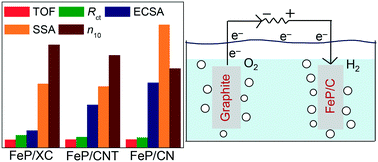The impact of microstructural features of carbon supports on the electrocatalytic hydrogen evolution reaction†
Abstract
Tremendous efforts are underway to design and develop Pt-less electrocatalysts for the hydrogen evolution reaction (HER). Because of its low cost and high electrical conductivity, carbon is used as a support material for the dispersion of active sites. While carbon supports play a critical role in the HER, the impact of key microstructural attributes of carbon on the properties and the performance of electrodes is yet to be determined. Herein, an attempt is made to investigate how certain carbon features determine the properties and the performance of electrodes towards the HER. This is exemplified by dispersing iron monophosphide (FeP) on three types of carbon supports with different properties, such as morphology, specific surface area, and electrical conductivity. The change in the electrode's properties, such as specific surface area, electrochemically active surface area, intrinsic electrical conductivity, surface charge transfer resistance, turnover frequency, and Tafel slopes, before and after FeP loading is examined and correlated with the performance. The findings of this study provide fresh impetus for designing and developing Pt-free active electrodes for the HER.



 Please wait while we load your content...
Please wait while we load your content...